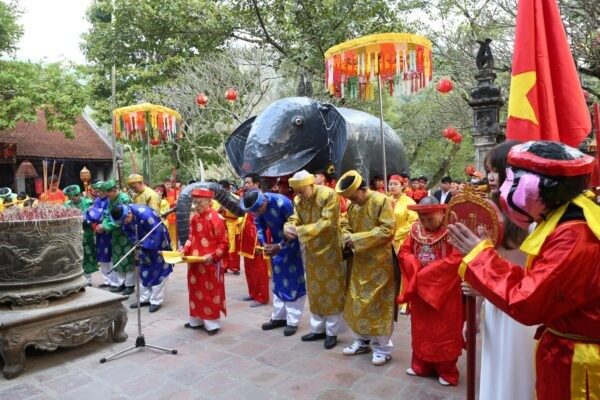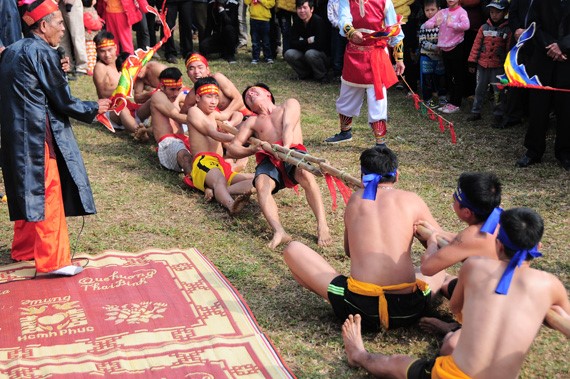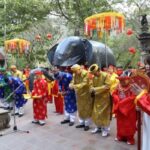Intangible cultural heritage is the heritage that shows the most unique features of Thang Long – Hanoi. Taking measures to preserve and promote the value of these heritages is to widely promote the beauty of these heritages, turn the heritage into a tourism product, and bring economic benefits to the local communities.
Recognizing this, Soc Son District has spent many years focusing on the preservation and promotion of intangible cultural heritages. The People’s Committee of Soc Son District recently announced Plan No. 104/KH-UBND on maintaining and developing the value of Soc Son District’s intangible cultural assets until 2025. Specific sets of solutions are proposed in order to organize implementation.
Soc Son District has 2 intangible cultural heritages that have been registered as Giong Festival at Soc temple (Phu Linh commune) and beak pulling ceremony in Xuan Lai hamlet (Xuan Thu commune). In addition, the district also has two intangible cultural heritages that are in danger of being lost and need to be prioritized for protection, including: So Temple Festival (also known as Tam Tong temple) in Phu Lo Commune; Huc Cau Festival in Xuan Duc hamlet (Tan Minh commune); and a number of communal house festivals in the district.

Giong Festival of Soc Temple with many traditional ceremonials are formally carried out
Photo: E-portal of Soc Son District
The Giong Festival of Soc Temple, in particular, is one of the largest festivals of Soc Son and the country in general, and was designated by UNESCO as a representative intangible cultural heritage of humanity in 2010. Festivals have become an essential part of everyone’s daily, cultural, and spiritual activities. Every year in the spring, people gather in Soc temple to pay their respects and ask for a year of peace and good fortune for themselves, their families, and loved ones. The Soc Temple Festival is held every year from the 6th to the 8th of January, according to tradition. At the festival, eight hamlets representing six communes are given the honor of preparing gifts and items to offer to Saint Giong on the festival’s opening day, which are as follows: Procession of bamboo flower springs, procession of war horses, war elephants, and betel nut, areca, elephant grass, tusk, procession of generals, and auspicious wishes. The form and content of festivals have a combination of ceremonials and festivals interwoven between folk beliefs, not only purely religious elements but also a form of spiritual and cultural activities imbued with religion principles, the tradition of honoring ancestors, “When you drink water, think of the source,” remembering the merits of the hero Saint Giong – who had the merit to protect the homeland and the country – one of the four immortals of the Vietnamese nation. For many years, Soc Son District has directed relevant agencies, departments, communes, hamlets and units to focus on well implementing a number of key contents when organizing the Giong festival in Soc temple, which are: propagandize to arouse and raise national pride and self-respect, educate the historical and cultural traditions, patriotic traditions and fight against foreign invaders of his fathers; fulfill the commitment with UNESCO on preserving and promoting the value of Giong festival at Soc temple – Representative intangible cultural heritage of humanity; Honor, preserve the architectural value and unique features of the Soc temple relic complex – a special national relic; at the same time, introduce and promote the potentials and strengths of Soc Son District to domestic and foreign tourists to develop tourism and develop socio-economic of the district.

The beak pulling ceremony is meticulously prepared and enthusiastic competition
The beak pulling ceremony (pulling with two bamboos, bending the beaks together, each team holding a tree, hence it is named as the beak pulling ceremony) in the festival of Vua Ba temple in Xuan Lai hamlet (Xuan Thu commune, Soc Son District) does not matter whether you win or lose. The beak pulling ceremony is held in January, but the Festivals Board and Hamlet Elders Board must begin preparations in the middle of the year. The Xuan Lai people select two lovely beautiful bamboos, each 7-8m long. The person picked to cut bamboo must be a model citizen with well-behaved children and grandchildren. The bamboos will be transported to the Vua Ba Temple after being cut to report and then “prepare beak.” The elderly must count the sheath using the words “Thinh, Suy, Bi, Thai.” The final two sheaths can only be Thinh or Thai words. Villagers frequently take 9 sheaths (falling in the word Thinh). Three more sheaths will be counted on the 9th sheath to be used to merge the beak. They were well prepared and competed with excitement, but at the end, they never declared a winner or a loser, simply a co-winner. Viewers must guess who will win and who will lose. In the opinion of the people of Xuan Lai hamlet, if the team standing in the south wins, the vast majority will have a good season, rain and wind. If the team standing in the north wins, they only get the white bean season and everything else is bad. The beak pulling ceremony has been maintained for hundreds of years, even during the resistance wars against the French and Americans, under difficult conditions, but people still tried to organize it. Since 2015, Xuan Lai beak pulling ceremony and games along with other tug-of-war games of Vietnam and other countries have been registered by UNESCO as the Representative Intangible Cultural Heritage of Humanity. Soc Son District organized a workshop on conservation and promotion of the beak pulling heritage in order to help the heritage live in the community’s life and let more people know about this heritage. In a number of cultural activities taking place in Soc Son District and in other areas, people in Xuan Lai hamlet had a chance of introducing beak pulling heritage to people. Specifically, performing at the Giong Festival at Soc Temple, performing at the Cultural Hamlet of Vietnam’s Ethnic Groups…
According to the Plan No. 104/KH-UBND, for Giong Festival at Soc temple, and beak pulling ceremony in Xuan Lai Hamlet, People’s Committee of Soc Son District will implement the UNESCO commitment contents when registering to the list of intangible cultural heritage representing humanity. Prepare periodic reports on the status of the intangible cultural heritage value protection and promotion registered by UNESCO in accordance with regulations. Heritage localities develop plans, organize the implementation of intangible cultural heritage value protection and promotion to be registered and recognized.
Soc Son District will prioritize investment resources, arrange research, collect and document history, and record documents to determine heritage values for the Den So and Huc Cau festivals in Xuan Duc Hamlet. Restore and practice to help safeguard and promote heritage values at risk of extinction, which should be prioritized for preservation. Compile historical brochures and teaching materials in order to preserve and pass on history to future generations.
Aside from preserving and promoting the value of intangible cultural heritages, the People’s Committee of Soc Son District has established a number of tasks to protect and promote the value of traditional festivals and handicrafts, types of folk literature, types of folk knowledge, and finally types of social practices and beliefs…
In order for the heritage to have a sustainable vitality and be known to more and more people in the future, Soc Son District has proposed solutions such as: encouraging community initiative and positivity in organizing and managing festival activities; strengthening propaganda and popularizing the meaning and content of the festival’s typical and unique values in order to help people understand and regconize their responsibility to the heritage; and supporting activities.
Nguyen Tam

